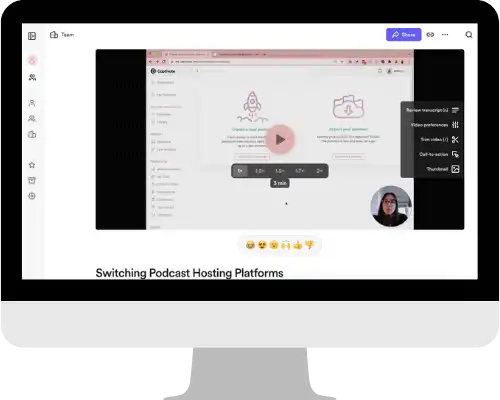Loom is a versatile, friendly screencasting tool that works on Macs, PCs, iPhones, Androids, and in Chrome browsers.
It’s very intuitive and creates easy-to-share videos for course creators or service providers. For example, you can use Loom to create online course videos, simple YouTube videos, training videos for internal team members, and even client review videos.
So in this Loom tutorial, I’ll show you how to record and edit videos in Loom. I’ll also share examples of how I use it in my own business, and point out features that set Loom apart from other screen recording software tools.
You can also watch my complete demo on the Wit & Wire YouTube channel:
5 ways to use Loom as an online business owner
Loom is a great tool for course creators and business owners because it is easy to use, and provides many features that I don’t see anywhere else.
So to share a few examples, here are 5 ways I personally use Loom as a solopreneur:
1. Create course lessons
Creating course lessons is straightforward with Loom. You can record your screen only, your camera only, or a mix of your screen plus a PIP (picture-in-picture) of your camera in the corner.
2. Communicate with prospective or existing clients
One of my favorite Loom features is that you can take the final recording URL and paste it into an email. When you do this, Loom provides a preview of the recording. In my experience, it’s a simple yet effective way to add a personal touch and elevate my communication with prospective and existing clients.
3. Help existing students within the Wit & Wire community
I often interact with students in the Wit & Wire community to offer feedback, answer questions, or take a look at something they’ve created.
Loom allows me to answer questions using examples from my business (or screen) or by providing a short demo, and send them back in video form – adding that personal touch.
4. Training and communication with the Wit & Wire team
With Loom, I’m able to create internal trainings for my team instead of having to spend time writing lengthy standard operating procedures (SOP). I’m also able to send quick demos or answer questions using Loom.
5. Create personalized pitches or proposals
When pitching a brand or publication, or proposing business opportunities, standing out from others who may be doing the same thing is always a plus.
Loom is a great way to provide actual examples of what you can offer or provide, as well as add that elevated and personal touch.
Now that I’ve shared specific ways I use the tool in my business, let’s get into the Loom tutorial.
Downloading Loom
When you decide you want to start using Loom, you have two main options: using the browser extension or desktop app.
While I do have both the browser extension and desktop app, I prefer to use the latter since it has a few extra features.
Recording your screen
Loom offers a number of different options to choose from when it comes to recording your screen. One of the features I love is that all the options are presented in a user-friendly drop-down menu.
First, you need to select what you want to see on your screen during your recording.
Full takeover
For a full takeover, Loom gives you the option to record your entire screen. This means that everything on your screen will appear in the recording – browser, desktop apps, etc.
Presenter view
I recommend using something called Presenter View. Selecting Presenter View causes a separate box with a spot for notes to pop up alongside the open browser or app window. This tool is super convenient because you can have notes or a script up while recording.
In Presenter View, your slides or other content that you’re recording is limited to the browser or app.
Recording settings
You have a few different options when it comes to setting up your recording.
The first thing you need to decide is if you want Loom to record you as well as your screen. Here are the options:
- Screen and camera: gives the option of a draggable ‘face’ along with the screen content
- Screen only: Loom will not record you, only what’s on your screen
- Camera only: records a standard rectangle size video of you
From there, a second drop-down menu provides options on how much of your screen you want Loom to record.
- Full screen: Loom will record everything, including browser tabs and anything else in view on your screen
- Window: Loom will record only what’s in a selected browser window
- Custom: you can drag your cursor and select the recording size
Once you’ve selected the features you want to utilize, it’s time to record. Hit ‘record’ and pause (you can trim later) and present your content. When you’re done with your recording, pause and then hit the stop button (again, you can trim this part later).
Loom will then open your recording in a new browser window.
Editing features in Loom
Once you’re ready to edit, the first thing I recommend is to change your recording file name (after you save, Loom gives each recording a default name). From there, you have the option to save your recording to folders within Loom.
Basic editing
The editing tool within Loom is your basic editing software. You can’t add animation or text in the video, for example, but you can trim and edit out mistakes or content you no longer want to include.
I always start by trimming the beginning and end of my recording. From there, I can edit any mistakes I’ve made within the recording using Loom’s ‘split’ tool. (If you make a mistake while recording, my recommendation is to pause for a couple of seconds afterward, so when you’re editing, it’s easier to spot the exact location.)
After you trim and edit out any mistakes or content, click save.
Video preferences
Loom gives you the option to turn on and off select features for your recording such as the ability for viewers to leave comments or download the recording.
Additionally, Loom provides the option to have your recording auto-transcribed, which, in my opinion, sets them apart from other free screen recording tools.
Sharing your recording
Loom provides a couple of different ways to share your recording. First, you can get a standard URL that will link back to your video.
One of my favorite Loom features is when you paste the URL into an email, a preview of the recording appears.
As I mentioned above, when I’m sharing videos with potential or existing clients, team members, or anyone else, it’s an eye-catching way to elevate my communication and makes it really personal.
Finally, Loom also provides the option to embed the video.
Pricing
The features I’ve shared in this tutorial are all free. However, Loom does offer additional features as part of their paid plans including specific video branding, additional sharing tools, the ability to embed links into a recording, and more.
To learn more about Loom pricing, visit their site here.
Loom tutorial wrap-up
Loom is a great free screen recording tool that I highly recommend for course creators and other small business owners. You can record videos for many things like creating demos, sending pitches, communicating with clients or students, personalized messages to anyone, or training team members.
Loom is a versatile, friendly screencasting tool that works on Macs, PCs, iPhones, Androids, and in Chrome browsers. It's very intuitive and creates easy-to-share videos for course creators or service providers.
To learn more about other tools I recommend, check out my complete online course toolkit here.

Melissa Guller is the founder of Wit & Wire, where we help everyday experts become profitable course creators. She previously worked full-time for Ramit Sethi, Teachable, and General Assembly. Today, she shares simplified tech tutorials and modern marketing strategies through our blog, YouTube, and Wit & Wire Weekly newsletter

